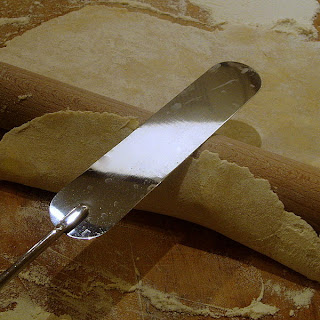I've set myself a new routine. I work for an hour and then take a 15 minute break. I was finding that working for 12-14 hours a day wasn't particularly productive, so I'm trying to work for concentrated short spells with programmed breaks. We'll see how it goes.
Today's breaks have been taken up with marmalade making!
A shopping trip to the local grocers on Saturday provided me with some of their reduced Seville oranges, only 50p for a kilo bag. Bargain. A bag for now and a bag for the freezer.
Now every B&B needs a plentiful supply of homemade marmalade, even though we don't actually have a B&B yet, there's nothing like being preparing for it!
 First 15 min slot
First 15 min slot. This was spent quartering
1kg of Seville oranges and removing the pips into a
jelly bag. The most effective way I've found of doing this is to place a jelly bag over a small bowl (to collect the juice) and then cut-out any strong white pith from the centre of the orange segments (and put this in the jelly bag too). This allows you to see the pips and easily scrape them out with a sharp knife.
Second slot (only about 5-10 mins). Blitz the oranges in a
magimix in two batches. I just use a normal blade and this gives a fairly thick-cut marmalade. But the slice blade (2 mm) can be used to get a lovely fine-cut marmalade. Cut
two lemons in half, remove the pips and add these to the other pips in the jelly bag. Put the chopped oranges, along with the jelly bag (tied-up with
string), the juice from the bowl below the jelly bag and the juice from the two lemons into a
preserving pan. Add
4 pints of water. Put on to gently
simmer for two hours. Put
two saucers or side plates into the freezer. And then time to make a cup of tea...
(The citrusy smell of the simmering oranges is making the whole house fill with an aroma akin to that of an orangery. I'm sure it's helping to inspire my writing.)
 Third slot (two-in-one)
Third slot (two-in-one). Preheat the oven to
140 degrees and rinse out some
jam jars in warm soapy water. This batch made: two Le Parfait jars (1x0.5 l, 1x0.75), an empty Peanut butter jar (340g Whole Earth) an empty mayonnaise jar (600g Hellmans) and another small jam jar.
Now you need to check the peel is soft. There's nothing worse than chewy marmalade. Do this by taking a piece of peel out of the pan and pressing the back of a fork against it. It should fall apart quite easily. When it is soft, remove the jelly bag, and add
2kg of preserving sugar and
200 grams of dark brown muscovado sugar, stirring all the time. (If you want a light orange marmalade then leave out the brown sugar.) Raise the temperature and bring the liquid to the
boil for about 15-20 mins. Put the empty jam jars in the oven. I put a
sugar thermometer in at this stage so I can check when it is getting close to a set at
105 degrees. At this point I then check for a set with the
'wrinkle test' by putting a small amount of the marmalade on one of the saucers from the freezer, let it cool for a while and then gently push the surface to see if it wrinkles. If not, carry on heating and try again a couple of minutes later. Put the saucer back in the freezer. I usually find I need to do this four or five times!

When it wrinkles, remove any white scum that has formed on top. I then add
100ml of whisky, but this optional, you could just put it straight into jars at this stage. The marmalade will bubble furiously when you add the whisky (I think it's burning-off the alcohol). Then
leave it for 15 mins before removing the jars from the oven and using a
jam funnel fill the jars.
Voila!
(Admittedly, the last slot took longer than 30 mins, but I did miss a break whilst it was boiling away.)






































